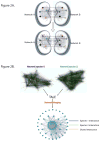Understanding kidney disease: toward the integration of regulatory networks across species
- PMID: 21044762
- PMCID: PMC2989742
- DOI: 10.1016/j.semnephrol.2010.07.008
Understanding kidney disease: toward the integration of regulatory networks across species
Abstract
Animal models have long been useful in investigating both normal and abnormal human physiology. Systems biology provides a relatively new set of approaches to identify similarities and differences between animal models and human beings that may lead to a more comprehensive understanding of human kidney pathophysiology. In this review, we briefly describe how genome-wide analyses of mouse models have helped elucidate features of human kidney diseases, discuss strategies to achieve effective network integration, and summarize currently available web-based tools that may facilitate integration of data across species. The rapid progress in systems biology and orthology, as well as the advent of web-based tools to facilitate these processes, now make it possible to take advantage of knowledge from distant animal species in targeted identification of regulatory networks that may have clinical relevance for human kidney diseases.
2010 Elsevier Inc. All rights reserved.
Figures


Similar articles
-
Systems biology of kidney diseases.Kidney Int. 2012 Jan;81(1):22-39. doi: 10.1038/ki.2011.314. Epub 2011 Aug 31. Kidney Int. 2012. PMID: 21881558 Free PMC article. Review.
-
Translational Metabolomics of Head Injury: Exploring Dysfunctional Cerebral Metabolism with Ex Vivo NMR Spectroscopy-Based Metabolite Quantification.In: Kobeissy FH, editor. Brain Neurotrauma: Molecular, Neuropsychological, and Rehabilitation Aspects. Boca Raton (FL): CRC Press/Taylor & Francis; 2015. Chapter 25. In: Kobeissy FH, editor. Brain Neurotrauma: Molecular, Neuropsychological, and Rehabilitation Aspects. Boca Raton (FL): CRC Press/Taylor & Francis; 2015. Chapter 25. PMID: 26269925 Free Books & Documents. Review.
-
Reverse-engineering human regulatory networks.Wiley Interdiscip Rev Syst Biol Med. 2012 Jul-Aug;4(4):311-25. doi: 10.1002/wsbm.1159. Epub 2012 Jan 13. Wiley Interdiscip Rev Syst Biol Med. 2012. PMID: 22246697 Free PMC article. Review.
-
The nephrologist of tomorrow: towards a kidney-omic future.Pediatr Nephrol. 2017 Mar;32(3):393-404. doi: 10.1007/s00467-016-3357-x. Epub 2016 Mar 9. Pediatr Nephrol. 2017. PMID: 26961492 Review.
-
Systems Biology and Kidney Disease.Clin J Am Soc Nephrol. 2020 May 7;15(5):695-703. doi: 10.2215/CJN.09990819. Epub 2020 Jan 28. Clin J Am Soc Nephrol. 2020. PMID: 31992571 Free PMC article. Review.
Cited by
-
Design of the Nephrotic Syndrome Study Network (NEPTUNE) to evaluate primary glomerular nephropathy by a multidisciplinary approach.Kidney Int. 2013 Apr;83(4):749-56. doi: 10.1038/ki.2012.428. Epub 2013 Jan 16. Kidney Int. 2013. PMID: 23325076 Free PMC article.
-
Integrative biology of renal disease: toward a holistic understanding of the kidney's function and failure.Semin Nephrol. 2010 Sep;30(5):439-42. doi: 10.1016/j.semnephrol.2010.07.001. Semin Nephrol. 2010. PMID: 21044755 Free PMC article. No abstract available.
References
Publication types
MeSH terms
Grants and funding
LinkOut - more resources
Full Text Sources
Medical

